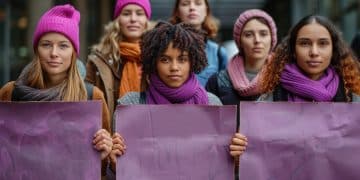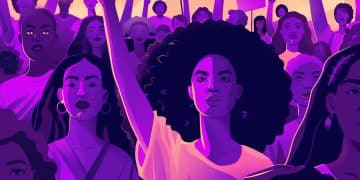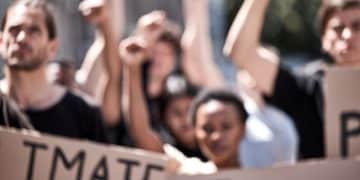LGBTQ+ rights demonstrations: a global perspective

Anúncios
LGBTQ+ rights demonstrations are crucial for advocating equality, challenging discrimination, and enhancing visibility for the community, utilizing social media and intersectional approaches to mobilize support and address diverse issues.
LGBTQ+ rights demonstrations are more than just gatherings; they represent a movement for equality and freedom. Have you wondered how these events shape our society? Let’s explore their significance.
Historical context of LGBTQ+ rights
The historical context of LGBTQ+ rights is essential to understanding the progress made and the challenges still faced. From the early days of persecution to the fight for equality, these events shaped the narrative of LGBTQ+ activism.
Anúncios
One significant moment in history was the Stonewall Riots of 1969. This pivotal event marked a turning point for LGBTQ+ rights, as individuals resisted police harassment at the Stonewall Inn in New York City. The riots ignited a movement, encouraging many to stand up for their rights.
Key Milestones in LGBTQ+ History
Several key milestones have influenced the LGBTQ+ rights movement:
- The decriminalization of homosexuality in various countries.
- The introduction of anti-discrimination laws to protect LGBTQ+ individuals.
- The legalization of same-sex marriage in numerous jurisdictions.
- The increased visibility of LGBTQ+ individuals in media and politics.
The progression of LGBTQ+ rights wasn’t smooth. Activists faced harsh backlash and legal obstacles. Nevertheless, the resilience of the community has led to remarkable advancements. Awareness campaigns and pride events play a vital role in normalizing LGBTQ+ identities, fostering a sense of belonging.
Anúncios
As we look at the trajectory of LGBTQ+ rights, it is clear that societal attitudes are shifting. Education and advocacy are crucial for debunking myths and reducing stigma. Continuing to tell stories of LGBTQ+ individuals helps to create empathy and understanding.
In conclusion, the historical context of LGBTQ+ rights illustrates the journey from oppression to acceptance. Each contribution made by activists has paved the way for future generations. Understanding this history empowers us to continue the fight for equality.
Key events in LGBTQ+ demonstrations
Several key events in LGBTQ+ demonstrations have significantly shaped the fight for equality and recognition. These events not only highlight the struggles faced by the community but also celebrate the victories achieved over time.
One notable event is the first Pride March held in 1970 in New York City. This march commemorated the one-year anniversary of the Stonewall Riots, symbolizing resilience and the demand for LGBTQ+ rights. It paved the way for annual Pride celebrations worldwide, fostering visibility and solidarity among community members.
Milestone Events in LGBTQ+ Rights
Other landmark events include:
- The AIDS activism of the 1980s, which brought attention to health disparities and government inaction.
- The 2015 U.S. Supreme Court decision that legalized same-sex marriage, marking a monumental achievement.
- The ongoing protests against discrimination, focusing on racial and gender diversity within the LGBTQ+ community.
- Annual Pride events that promote acceptance and raise awareness globally.
These key events demonstrate that LGBTQ+ demonstrations are not only about celebration but also about advocacy and fighting for justice. Each protest and march serves as a reminder of the work still needed to achieve full equality.
Moreover, the rise of social media has transformed how these events are organized and publicized. Platforms allow activists to reach wider audiences, share stories, and mobilize support quickly. The impact of digital communication cannot be overstated, as it plays a crucial role in rallying community members and supporters alike.
The role of social media in mobilizing

The role of social media in mobilizing LGBTQ+ demonstrations has been transformative. With platforms like Twitter, Instagram, and Facebook, activists can share their messages widely and quickly. These tools have made it easier for people to connect, organize, and advocate for change.
Social media allows for real-time updates during demonstrations, helping to inform supporters about events and logistics. Live streaming of protests gives people a chance to witness activism firsthand, even from afar. This immediacy fosters a sense of urgency and encourages participation.
How Social Media Amplifies Voices
Several key factors illustrate how social media empowers LGBTQ+ movements:
- The ability to reach global audiences instantly.
- Creating online communities where individuals can share their stories and experiences.
- Organizing events and campaigns, such as hashtag movements that raise awareness.
- Fundraising for LGBTQ+ organizations and initiatives directly through these platforms.
Moreover, social media can expose injustices and promote solidarity among diverse groups. It creates platforms for underrepresented voices, enhancing discussions around intersectionality within the LGBTQ+ community. By highlighting various perspectives, social media contributes to a more inclusive dialog.
As more individuals engage online, the movement gains momentum. Social media also allows for representation and visibility, especially for marginalized groups within the LGBTQ+ community. This representation is crucial for advancing understanding and acceptance in society.
Challenges faced by activists
Activists fighting for LGBTQ+ rights encounter various challenges in their pursuit of equality and acceptance. These obstacles can hinder progress and affect the overall impact of their efforts. Understanding these challenges is essential to support the movement further.
One significant challenge is discrimination and hostility from certain groups. Activists often face backlash during demonstrations, which can escalate to violence. This creates a dangerous environment that discourages participation and can inhibit the growth of the movement.
Common Challenges Encountered
Activists deal with numerous hurdles, including:
- Legal barriers that limit rights, such as anti-LGBTQ+ legislation.
- Societal stigma that fosters misunderstanding and prejudice.
- Lack of funding for initiatives that promote LGBTQ+ advocacy.
- Fatigue and burnout from continuous fighting against systemic inequalities.
Additionally, there is the challenge of intersectionality. Many activists belong to multiple marginalized groups. This makes their activism unique but also complicates their efforts. It’s crucial to recognize the diverse experiences within the LGBTQ+ community to ensure that all voices are heard.
Moreover, the rapid pace of social media can amplify challenges. Misleading information can spread quickly, leading to confusion and division within the community. Activists must combat misinformation while also utilizing social media as a tool for awareness and mobilization.
Future of LGBTQ+ rights movements
The future of LGBTQ+ rights movements holds both challenges and opportunities as society continues to evolve. As awareness grows, so does the potential for advancements in equality and representation. Activists are dedicated to ensuring that progress is made for all members of the community.
One important aspect is the emphasis on intersectionality. Activists are increasingly recognizing the need to address issues that affect individuals with multiple identities, such as race, gender, and sexuality. This approach ensures that the voices of the most marginalized are heard and prioritized.
Emerging Trends in LGBTQ+ Activism
Several noticeable trends signal how the future of LGBTQ+ movements may develop:
- Increased use of technology for organizing and advocacy, allowing for broader outreach.
- Enhancing global solidarity as movements in different countries support one another.
- Focus on mental health resources for LGBTQ+ individuals, highlighting the importance of well-being.
- Efforts to create inclusive policies in workplaces and educational institutions.
Moreover, younger generations are becoming more engaged in activism. They leverage social media to amplify their messages and mobilize support for various causes. This tech-savvy approach enables them to connect with others worldwide and engage in real-time discussions about issues affecting the community.
The landscape of LGBTQ+ rights is also shifting in response to political changes. Advocacy groups must remain adaptable and vigilant, as laws and attitudes can change rapidly. Building alliances with other movements and advocating for comprehensive policies will be vital for sustainable progress.
In conclusion, the fight for LGBTQ+ rights is ongoing and critical. With a rich history of activism and a hopeful future, each generation builds on the progress of the last. Challenges remain, but through solidarity, innovation, and determination, the movement continues to grow. Together, we can create a world that values diversity, equality, and acceptance for all.
FAQ – Frequently Asked Questions about LGBTQ+ Rights Movements
What are the main goals of LGBTQ+ rights movements?
The primary goals include achieving equality, protection from discrimination, and raising awareness about LGBTQ+ issues.
How has social media impacted LGBTQ+ activism?
Social media has enabled activists to connect and organize quickly, share stories, and amplify their messages to broader audiences.
What challenges do LGBTQ+ activists face today?
Activists confront issues like discrimination, legal barriers, misinformation, and the need for greater intersectionality within movements.
What is the importance of intersectionality in LGBTQ+ rights?
Intersectionality ensures that the experiences of individuals with multiple identities are recognized and addressed, promoting a more inclusive movement.





